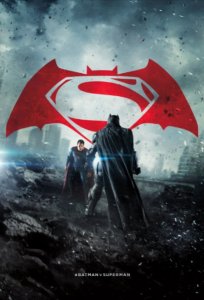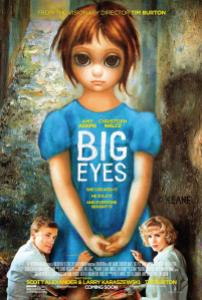Zack Snyder’s follow-up to “Man of Steel” pits Superman and Batman against each other.
 Have blockbusters really come to this? We’ve grown so desperate to make superheroes dark, gritty and realistic that we’ve fallen to sticking Superman, in full spandex, in front of Congress? “Batman v. Superman: Dawn of Justice” has it all: senatorial hearings, editorial newsroom meetings, CNN, Charlie Rose? It’s the spectacle of the new millennium!
Have blockbusters really come to this? We’ve grown so desperate to make superheroes dark, gritty and realistic that we’ve fallen to sticking Superman, in full spandex, in front of Congress? “Batman v. Superman: Dawn of Justice” has it all: senatorial hearings, editorial newsroom meetings, CNN, Charlie Rose? It’s the spectacle of the new millennium!
Director Zack Snyder has officially made superhero movies no fun. Whereas Snyder’s “Man of Steel” was depressing, overly tragic and evoked disturbing 9/11 mayhem for action, “Dawn of Justice” is messy, overstuffed, boring, and still manages to double down on “Man of Steel’s” doom and gloom.
“Dawn of Justice” opens with a revisit of Bruce Wayne’s tortured childhood, when his parents were killed in a mugging. Anyone even remotely familiar with Batman will know this story, so Snyder’s just making exploitative melodrama. The super slow motion gun chamber blasts and falling pearls from Martha Wayne’s shattered necklace are laying it on a bit thick, no? Snyder then takes us back to the titanic battle at the end of “Man of Steel,” with Bruce Wayne (Ben Affleck) horrified at the havoc Superman can wreak. Bruce swears to find a way to beat Superman, while Clark Kent (Henry Cavill) believes Batman to be the dangerous criminal and vigilante.
18 months later, Superman is the figure of heated political controversy. Has Superman been sent by God, is he human, or is he God himself? And if he has the power to bring about our destruction, can he be trusted and held accountable? Except Snyder doesn’t actually explore or consider any of these themes through drama and storytelling. We have to endure an endless torrent of TV talking heads spouting claptrap analysis on cable news, or Superman being called before Congress in an oversight committee held by Senator Finch (Holly Hunter). Snyder even dragged Neil DeGrasse Tyson into this mess.
When it’s not Anderson Cooper debating the moral dilemma behind Superman, it’s Lex Luthor (Jesse Eisenberg), the head of a massive, nebulous company called Lexcorp. What movie exactly does Jesse Eisenberg think he’s in? Dressed in a baby blue suit and white sneakers with a wild mane of dirty brown hair, Eisenberg delivers a fast-talking, wide-eyed performance as less an ironic, tongue-in-cheek, super villain and more an eccentric mental patient. Luthor has for some reason declared his own war on Superman, and by extension a vengeance against God, utilizing his infinite resources to gain access to Superman’s only weakness, the mineral Kryptonite, and devise experiments on the body of the defeated General Zod.
Snyder goes all over the place in this story (written by “Argo’s” Chris Terrio and “Man of Steel’s” David S. Goyer). There’s an apocalypse dream sequence complete with a desert wasteland and unexplained mutant hornets policing the planet. There’s the sexy Diana Prince (Gal Gadot) needlessly inserting herself into Bruce Wayne’s business. And there are more than a few diversions to introduce the other members of the upcoming Justice League movie.
At no point however does Snyder tease out a strong main tension for the movie, a reason to care for the outcome of a fight between Superman and Batman or even urging us to root for a particular side. If it’s the fate of the world at stake, “Dawn of Justice” needs to do a better job than superficially profound lines about morality. “The world has been so caught up with what he can do that no one has asked what he should do,” or, “Devils don’t come from hell beneath us. They come from the sky.”
Snyder has also lost all his credibility as a visual stylist. While not as washed of color as “Man of Steel,” “Dawn of Justice’s” ending epic battle is a dizzying CGI laser-light show, in which Superman and another unstoppable behemoth wail on one another without consequence. And while some critics took Christopher Nolan to task for some sloppy editing and continuity within “The Dark Knight,” the car chase here is simply incomprehensible.
Affleck is a fine Batman, but his version of conflicted and tortured means being slow and lumbering. Cavill doesn’t fare much better as a perfectly bland Clark Kent. Eisenberg simply feels out of place. And poor Amy Adams. She’s taking Lois Lane far too seriously than this movie requires.
Every origin story has been told, every universe explored, every franchise booted and rebooted, and now as superhero movies have dominated popular culture, filmmakers have taken it upon themselves to fit their comic book idols into the real world. “Dawn of Justice” poses questions of governmental oversight that no one cared to ask, and in the process, the genre itself has ceased to be fun. Perhaps in the sequel, Superman can take out a mortgage and settle down into a nuclear family.
1 ½ stars
 Perhaps no one other than fashion designer Tom Ford (A Single Man) could’ve nailed the beautiful, perverse, bizarre blend of high and low art he attains in Nocturnal Animals. Equal parts alluring and sickening, sexy and bleak, lush and trashy, Ford’s film within a film is deliciously silly pulp, but also stylishly deep and smart in its examination of psychology and privilege.
Perhaps no one other than fashion designer Tom Ford (A Single Man) could’ve nailed the beautiful, perverse, bizarre blend of high and low art he attains in Nocturnal Animals. Equal parts alluring and sickening, sexy and bleak, lush and trashy, Ford’s film within a film is deliciously silly pulp, but also stylishly deep and smart in its examination of psychology and privilege.
 Have blockbusters really come to this? We’ve grown so desperate to make superheroes dark, gritty and realistic that we’ve fallen to sticking Superman, in full spandex, in front of Congress? “Batman v. Superman: Dawn of Justice” has it all: senatorial hearings, editorial newsroom meetings, CNN, Charlie Rose? It’s the spectacle of the new millennium!
Have blockbusters really come to this? We’ve grown so desperate to make superheroes dark, gritty and realistic that we’ve fallen to sticking Superman, in full spandex, in front of Congress? “Batman v. Superman: Dawn of Justice” has it all: senatorial hearings, editorial newsroom meetings, CNN, Charlie Rose? It’s the spectacle of the new millennium! A woman is carefully studying one of Margaret Keane’s paintings of a waif like child with big eyes in a state of poverty and despair. She says, “It’s creepy, maudlin and amateurish. And I love it.”
A woman is carefully studying one of Margaret Keane’s paintings of a waif like child with big eyes in a state of poverty and despair. She says, “It’s creepy, maudlin and amateurish. And I love it.”